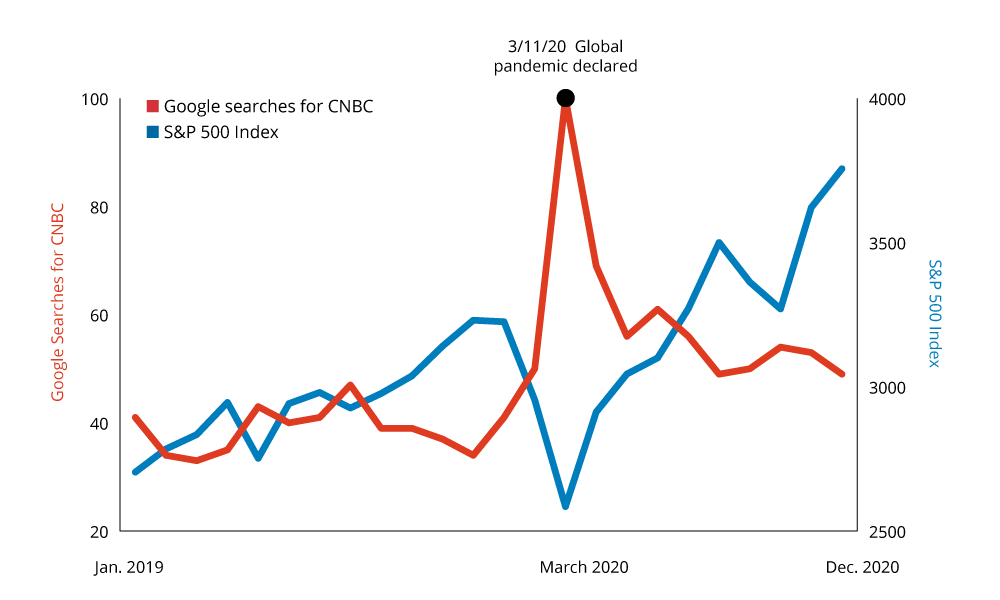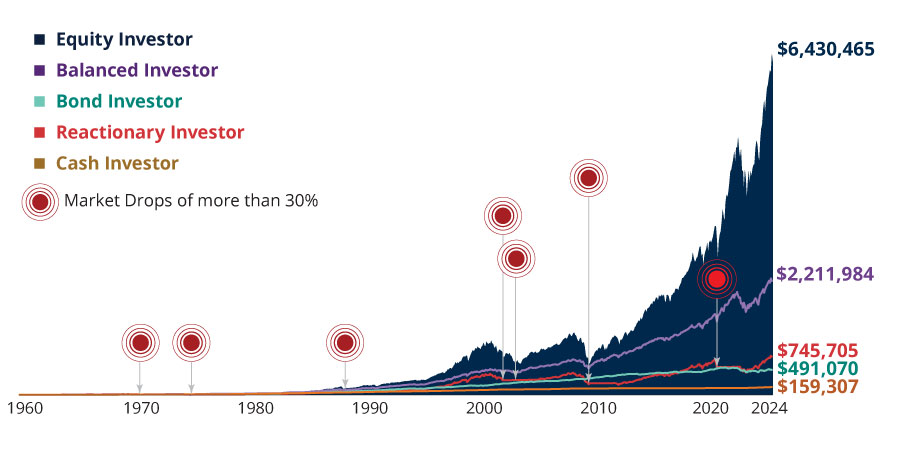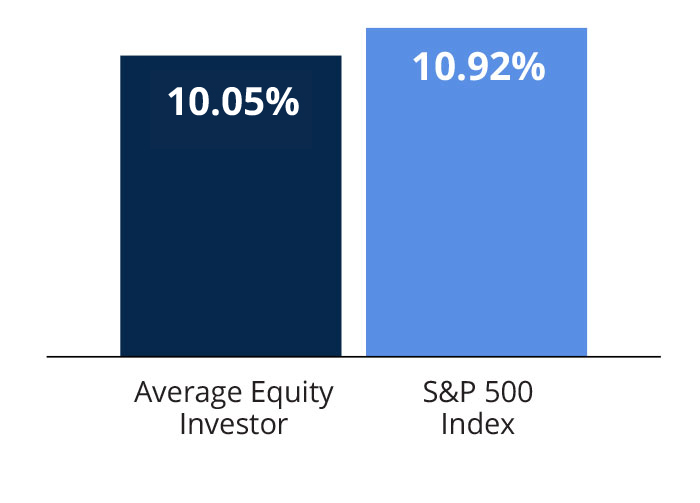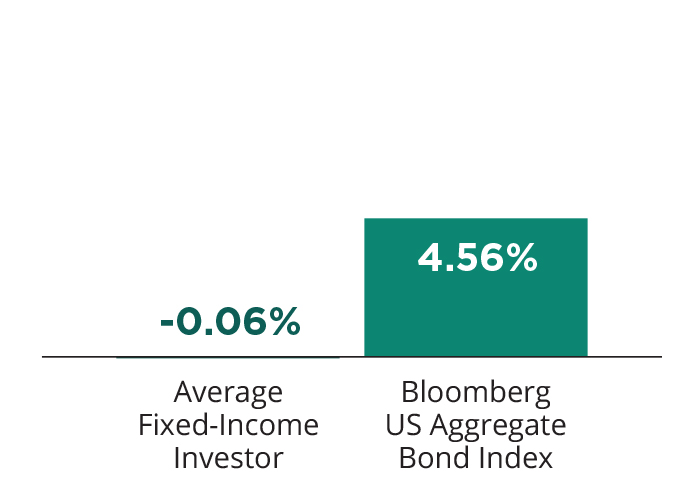In any crisis, “playing it safe” to avoid losing your money can seem like the only rational strategy. However, in the past 60 years, we’ve seen repeating patterns of crises. Despite these crises, the market has been resilient. The Dow Jones Industrial Average rose from 679 points in 1959 to over 38,000 in 2024.* Regardless, of the type of crisis, history shows that long-term investors who stayed the course through crises and didn’t lose sight of their financial goals have been rewarded.
There’s Always a Reason to Panic: 30%+ Drops in the S&P 500 Index 1960–2024
When the market is declining and the news is depressing, the urge to panic and “play it safe” can be intense. How an investor chooses to respond to this turmoil can dramatically affect his or her long-term performance. Investors are more likely to find the courage to re-enter the market after things quiet down. Unfortunately, by this time, they’ve already missed much of the recovery. (Source: Ned Davis Research, 12/25)
 -36% 11/29/68-5/26/70 Interest rates rose above 9% Vietnam War |
 -48% 1/11/73- Middle East oil embargo Watergate |
 -34% 8/25/87- Black Monday: the Dow Jones Industrial Average dropped 22% in a single day |
 -37% 3/24/00- Dot-com bubble Accounting scandals 9/11 |
 -34% 1/4/02- WorldCom collapse Tyco executives indicted Ford closes five plants |
 -57% 10/9/07- Housing bubble Financial crisis |
 -34% 2/19/20- Global pandemic |
 -36% 11/29/68-5/26/70 Interest rates rose above 9% Vietnam War |
 -48% 1/11/73-10/3/74 Middle East oil embargo Watergate |
 -34% 12/4/87-10/19/87 Black Monday: the Dow Jones Industrial Average dropped 22% in a single day |
 -37% 3/24/00-9/21/01 Dot-com bubble Accounting scandals 9/11 |
 -34% 1/4/02-10/9/02 WorldCom collapse Tyco executives indicted Ford closes five plants |
 -57% 10/9/07-3/9/09 Housing bubble Financial crisis |
 -34% 2/19/20-3/23/20 Global pandemic |
First, Stress, Anxiety, and Crises
When crises hit, news ratings surge. For example, in the early days of the global pandemic, from March 16-20, 2020 Fox News saw its ratings climb 89% over the prior year period, while CNN was up 193%, and MSNBC climbed 56%.1
In addition to more news consumption, we’re searching CNBC more often to see how the market is performing. All this news watching and Googling can make us more anxious about the economy.
When we’re anxious, we’re more likely to allocate our attention to negative information.2 Given the choice between information that may offer an optimistic perspective or data that paints a bleak future, an anxiety-influenced investor may naturally focus on threatening information.
When Markets Fall, We Search—Especially For CNBC
Google Searches for CNBC vs. S&P 500 Index

This is a study of Google searches for “CNBC” compared with S&P 500 Index performance. The blue line represents the S&P 500 Index and the red line represents Google searches. Do you see a pattern? There’s a correlation between poor market performance and CNBC searches.
Past performance does not guarantee future results. See below for index descriptions. For illustrative purposes only. Indices are unmanaged and not available for direct investment.
Source: Google Trends/Factset, 12/21
Second, The Risk of Mistakes
Let’s face it, there are good reasons to be anxious about a crisis’ effect on our economy. When anxiety increases, many investors respond by trying to make their portfolios safer. In 2024, total assets in cash investments reached an astounding $18.9 trillion.3 Cash investments may provide a sense of security because of their perceived benefit of principal stability.
Making a portfolio safer seems perfectly rational during a crisis. Nobody likes losing money, especially when the market plunges. The pain of losing money is psychologically about twice as intense as the pleasure of gaining it.4 When the market drops 30% or more, that pain and temptation to make a portfolio safer can intensify. Since 1960, the market dropped more than 30% seven times.
Although safer investments can calm our anxiety when the market’s tumbling, choosing safety can be a mistake for long-term investors. The graph below illustrates how a hypothetical “reactionary” investor, who made their portfolio safe when the market dropped 30%, missed gains time and time again during market recoveries. The reactionary investor traded long-term results for short-term comfort.
The Price Of Panic
Despite repeated, sometimes verbatim, predictions of dire global catastrophe or outrageous economic boom, the markets have been resilient to either hyped extreme.
$10,000 Invested S&P 500 Index 12/31/59–12/31/24

The combination of market volatility and the constant drumbeat of negative news can make it difficult to stay calm—even for experienced investors. But giving in to panic by making abrupt changes to your portfolio could be detrimental to your long-term investment returns.
Past performance does not guarantee future results. For Illustrative purposes only. Indices are unmanaged and not available for direct investment. U.S. Treasury securities are backed by the full faith and credit of the U.S. Government. Equities and bonds are subject to risks and may not be suitable for all investors. Source: Ned Davis Research, 12/25
Equity returns are represented by the S&P 500 Index. Bond IA SBBI US Long Term Bond Index until 1976 and the Bloomberg US Aggregate Bond thereafter. Reactionary returns indicate the results of an investor who invested in S&P 500 Index, moved 100% into 90-Day T-Bills each time the market dropped 30% and then moved 100% back into S&P 500 Index two years later. Balanced Returns are represented by 50% S&P 500 Index and and 50% IA SBBI US Long Term Bond Index until 1976 and the Bloomberg US Aggregate Bond thereafter. Cash returns are represented by 90-Day T-Bills.
Third, Maintaining Perspective in Crises
Nobody likes to go through a crisis alone. Trying to manage your investments by yourself in a crisis, with extreme market volatility, can be mind-boggling. In March of 2020, the Dow swung several times between 6–12% a day in both directions. One day the Dow Jones Industrial Average was down 2,000 points and a few days later up 2,000 points. It can be unnerving to hear “worst day ever” and then “best day ever” in terms of market point moves.
Many investors try to time the market’s ups and downs and change their portfolio investments accordingly. Research shows that this strategy hasn’t worked well for investors. Dalbar’s Quantitative Analysis of Investor Behavior studied has measured the effects of investor decisions to buy, sell, and switch into and out of mutual funds over short and long-term time frames. The results consistently show that the average investor returns are less—in many cases, much less—than market index return.5
Hopping in and out of investments to prevent losses or capture gains can be a primary reason why investors have underperformed the market. Anxious investors tend to overestimate the risk of holding stock investments and underestimate the risk of not holding them.
Over the past 30 years, the average equity fund investor earned a 10.00% annualized return vs. a 10.92% annualized return of the S&P 500 Index.5 The average bond investor earned -0.5% vs. a 4.56% return of the Bloomberg US Aggregate Bond Index.5 The bottom line: investor behavior can determine success more than investment performance.
That’s why it’s important to have the support of a financial professional who can help you control impulsive reactions to market volatility and practice disciplined investing. In addition to helping you find appropriate investments for your financial goals, your financial professional plays a more crucial role by acting as a counter to the market’s mind games that can tempt even experienced investors.
Individual Investors Have Underperformed Market Indices
Average Annual Returns for the 30 Year Period Ending 12/31/2023


Data Source: DALBAR’s Annual Quantitative Analysis of Investor Behavior (QAIB), 2025. Performance data for indices represents a lump sum investment in January 1995 to December 2024 with no withdrawals. Stocks are represented by the S&P 500 Index. Bonds are represented by the Bloomberg US Aggregate Bond Index. Past performance does not guarantee future results. Performance data for indices represents a lump-sum investment in January 1995 to December 2024 with no withdrawals. Indices are unmanaged, unavailable for direct investment, and do not reflect fees, expenses, or sales charges. See last slide for index descriptions.
Please see below for the calculation of the average equity and fixed-income investor.
“But It’s Different This Time”
Many feel that the current crisis is different than previous crises. It is. Every crisis is different. With all the news coverage, we can feel like today is bad and tomorrow will be worse. It’s easy to get overwhelmed with pessimism. But despite all the bad news, there’s amazing innovation taking place that won’t get media attention.
For example, Elon Musk’s Neuralink developed brain-computer interface, connecting brains to computers for improved cognition and treatment of neurological disorders.6 Many customers love self-driving robotaxis. In August, Waymo provided nearly 500,000 rides in California. Uber and Lyft will join soon.7 Meta will build the world’s longest undersea cable to improve the world’s digital highways.8 Agentic AI focuses on action and decision-making, adapting to environments. These agents plan trips, serve as virtual caregivers, and optimize supply chains, autonomously solving problems and transforming industries.9
The US has experienced 26 bear markets since 1929.10 Our recovery record? 26 for 26. While we can’t predict the future, as Warren Buffett has said, “It’s never paid to bet against America.”
Three Things to Remember About Maintaining Perspective
First, crises influence us to focus on the negative. The flood of 24/7 crisis news coverage can contribute to our anxiety about the economy. Second, anxiety makes us more vulnerable to making investment mistakes that can damage our long-term results. Third, consider working with a financial professional to help you maintain a long-term perspective through the crisis.
Next Step: Talk to your financial professional about how to keep a long-term perspective through crises
| Financial Professionals: This article is based off of our popular Media Replay module. Click here to access additional content to share. |
*Past performance does not guarantee future results. Indices are unmanaged and not available for direct investment.
Investing involves risk, including the possible loss of principal. Fixed income security risks include credit, liquidity, call, duration, and interest-rate risk. As interest rates rise, bond prices generally fall.
Hartford Mutual Funds may or may not be invested in the companies referenced herein; however, no particular endorsement of any product or service is being made. This material is provided for educational purposes only.
Sources:
1 Ratings Skyrocket for Cable News Amid Wall-To-Wall Coronavirus Coverage, Newsweek, 3/23/20
2 Fear, Finance, and The High Anxiety Client, MIT AgeLab, 2016
3 Board of Governors of the Federal Reserve System (US), 2024
4 What Is Loss Aversion? Psychology Today, 3/8/18
5 Quantitative Analysis of Investor Behavior, Dalbar, 2025
6 Elon Musk says his Neuralink startup has implanted a chip in its first human brain, CNN, 1/30/24
7 How Uber and Lyft Are Gearing Up for the Robotaxi Revolution, Forbes, 1/6/25
8 Meta Will Build the World’s Longest Undersea Cable, Wired, 2/19/25
9 Generative AI Vs. Agentic AI: The Key Differences Everyone Needs To Know, Forbes, 2/3/25
10 Ned Davis Research, 12/25
Dalbar’s Quantitative Analysis of Investor Behavior Methodology - Dalbar’s Quantitative Analysis of Investor Behavior uses data from the Investment Company Institute (ICI), Standard & Poor’s, and Bloomberg Index Products to compare mutual fund investor returns to an appropriate set of benchmarks. Covering the period from January 1, 1995 to December 31, 2024, the study utilizes mutual fund sales, redemptions and exchanges each month as the measure of investor behavior. These behaviors reflect the “average investor.” Based on this behavior, the analysis calculates the “average investor return” for various periods. These results are then compared to the returns of respective indices.
Average equity investor and average bond investor performance results are calculated using data supplied by ICI. Investor returns are represented by the change in total mutual fund assets after excluding sales, redemptions, and exchanges. This method of calculation captures realized and unrealized capital gains, dividends, interest, trading costs, sales charges, fees, expenses, and any other costs. After calculating investor returns in dollar terms, two percentages are calculated for the period examined: total investor return rate and annualized investor return rate. Total investor return rate is determined by calculating the investor return dollars as a percentage of the net of the sales, redemptions, and exchanges for each period.
Hartford Mutual Funds may or may not be invested in the companies referenced herein; however, no particular endorsement of any product or service is being made. This material is provided for educational purposes only.
Index Descriptions
Indices are unmanaged, and unavailable for direct investment, and do not represent the performance of any Hartford Funds.
Dow Jones Industrial Average is a market capitalization-weighted price index composed of 500 widely held common stocks.
S&P 500 Index is a market capitalization-weighted price index composed of 500 widely held common stocks.
Bloomberg US Aggregate Bond Index is composed of securities that cover the US investment-grade fixed-rate bond market, with index components for government and corporate securities, mortgage pass-through securities, and asset-backed securities.
IA SBBI US LT Corp measures the performance of US dollar-denominated bonds issued in the US investment-grade bond market including US and non-US corporate securities that have at least ten years to maturity and a credit rating of AAA/AA.
IA SBBI US 30 Day T-Bill measures the performance of a single issue of outstanding Treasury Bill which matures closest to, but not beyond, one month from the rebalancing date. The issue is purchased at the beginning of the month and held for a full month; at the end of the month that issue is sold and rolled into a newly selected issue. The index is calculated by Morningstar and the raw data is from WSJ.
“Bloomberg®” and any Bloomberg Index are service marks of Bloomberg Finance L.P. and its affiliates, including Bloomberg Index Services Limited (“BISL”), the administrator of the indices (collectively, “Bloomberg”) and have been licensed for use for certain purposes by Hartford Funds. Bloomberg is not affiliated with Hartford Funds, and Bloomberg does not approve, endorse, review, or recommend any Hartford Funds product. Bloomberg does not guarantee the timeliness, accurateness, or completeness of any data or information relating to Hartford Fund products.





